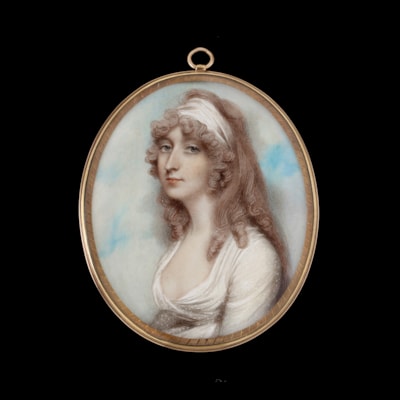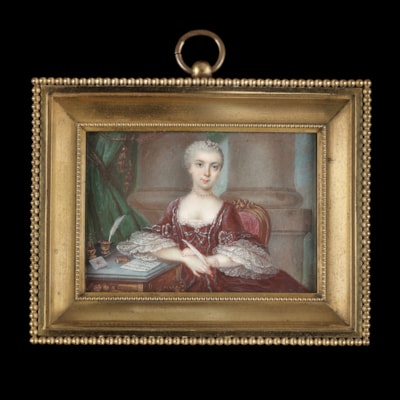HUGH DOUGLAS HAMILTON
(1739-1808)Portrait of The Reverend Frederick William Blomberg, D.D. (1761-1847), as a child
Dated '1769'
Pencil and watercolour on paper
Museum mount, unframed
28 x 23 cm (11 x 9 inches)
SOLD
The child’s origins were and are largely uncertain. Said to have been born in 1761 to a naval captain, Major Frederick Blomberg, and his wife Mellissa Laing, the young Blomberg was apparently ushered into the upper echelons of society on the death of his father and adopted by Queen Charlotte of England in 1765, who raised the child alongside the future King George IV (1762-1830) in the Royal nurseries. Certainly it would seem strange that the young Queen Charlotte, who by 1765 had three sons of her own, would adopt a child (who looked extremely similar to his adoptive siblings) born just a year before the Prince Regent. A more recent suggestion has been that the child was in fact a son of the king’s brother, most likely Edward, Duke of York, who was to die in 1767.[2] George III’s heightened sense of duty may have compelled him to take in this illegitimate nephew, despite the rumours that followed his decision. A satisfactory explanation has been sought by many later historians, but has not been found, leading to extraordinary stories in the nineteenth century concerning ghosts and apparitions.[3]
In his mid-twenties, Blomberg joined the church and held numerous important positions, including Prebendary of Bristol (1790-1828) and Westminster (1808-1822) and Chaplain to George, Prince of Wales (future George IV) between 1793 and 1830. He is also listed as Clerk of the Closet to the Prince of Wales from 1808.[4] In 1812, the Prince Regent offered Blomberg ownership of the Manor of Kirby Misperton in Yorkshire, which had previously belonged to the descendants of Baron Blomberg, envoy to the Court of William III and Mary and to whom Blomberg claimed connection.
As noted, the circumstances surrounding his public achievements, Royal favour and mysterious adoption have never been fully explained. At the time, to counteract rumours of paternity, a partly fabricated story was constructed, the essence of which was detailed in the Journal and Memories of Thomas Whalley, 1863 (ed. Rev. Hill Wickham). This account outlined that George III became aware of Blomberg and took him in having heard about the tragic death of the child’s father in the West Indies. Independently of this tale, the known facts of the case were revisited by Lord Amulree and Christopher Dobson in ‘Who was Count Blomberg?’ an article in Country Life on 27th August 1964. These gentlemen concluded that Blomberg’s success both in the Church and elsewhere could only be satisfactorily explained if there was indeed some truth behind the rumour of a Royal connection.
Blomberg was known for his musical talent, and it was comically noted by a contemporary that whilst ‘he was poor in his sermons, […] on the fiddle had few superiors.’ Such an aptitude must have manifested from a young age as is evidenced in the present work through inclusion of the violin in the lower portion of the composition. Drawn in pencil and dated 1769, this portrait portrays the eldest child in the royal nursery at that date – and is proof that, for the king and queen at least, he was considered an established member of the family.
[1] The drawings are all noted in Oppé, A.P., 1950. English Drawings in the Collection of His Majesty The King at Windsor Castle, London, p. 54, the one of the Queen illustrated as plate 6.
[2] This was suggested by Robert (later Sir) Mackworth Young, then Librarian of Windsor Castle and Assistant Keeper of the Queen’s Archives in a letter written in 1964 to Christopher Dobson, Librarian of the House of Lords. The letter was partially transcribed in P. Beauclerk-Dear and R. Powell, Royal Bastards, 2008, p. 215.
[3] A ghost story was woven in the narrative surrounding the mysterious Blomberg boy in the 19th century. This story stated that, following the death of his father, Major Frederick Blomberg, who allegedly drowned enroute to Dominica, Frederick William was brought up by Queen Charlotte in the royal household. His father's ghost then supposedly appeared to the governor of Dominica to tell him the whereabouts of his other two children, the orphaned offspring of his secret marriage, who were housed with a distant English relative.
[4] The Clerk of the Closet is responsible for advising the Private Secretary to the Sovereign on the names for candidates to fill vacancies in the Roll of Chaplains to the Sovereign. He presents bishops for homage to the Sovereign, examines any theological books to be presented to the Sovereign, and preaches annually in the Chapel Royal, St James's Palace (source: Wikipedia).
in 1865 to Robert Tindall;
John and Robert, sons of Robert Tindall, who conveyed it at their father's death in 1903 to Mr. J. R. Twentyman;
thence by descent.

shipping notice
Worldwide shipping is included in all prices.
The Limner Company does not accept any responsibility for import duty, this is to be paid by the buyer.
Some stock items contain materials from endangered species which are governed by CITES regulations and will require a permit to export outside of Great Britain. If a certificate of export is required then this will be the responsibility of and paid for by the buyer .
you may also like













